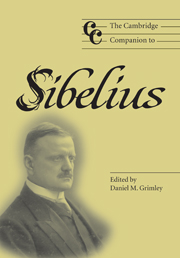Book contents
- Frontmatter
- Introduction
- Part I Forging a voice: perspectives on Sibelius's biography
- Part II Musical works
- 3 Pastoral idylls, erotic anxieties and heroic subjectivities in Sibelius's Lemminkäinen and the Maidens of the Island and first two symphonies
- 4 The later symphonies
- 5 The genesis of the Violin Concerto
- 6 Finlandia awakens
- 7 The tone poems: genre, landscape and structural perspective
- 8 Finnish modern: love, sex and style in Sibelius's songs
- 9 Sibelius and the miniature
- Part III Influence and reception
- Part IV Interpreting Sibelius
- Notes
- Select bibliography
- Index of names and works
8 - Finnish modern: love, sex and style in Sibelius's songs
from Part II - Musical works
Published online by Cambridge University Press: 28 September 2011
- Frontmatter
- Introduction
- Part I Forging a voice: perspectives on Sibelius's biography
- Part II Musical works
- 3 Pastoral idylls, erotic anxieties and heroic subjectivities in Sibelius's Lemminkäinen and the Maidens of the Island and first two symphonies
- 4 The later symphonies
- 5 The genesis of the Violin Concerto
- 6 Finlandia awakens
- 7 The tone poems: genre, landscape and structural perspective
- 8 Finnish modern: love, sex and style in Sibelius's songs
- 9 Sibelius and the miniature
- Part III Influence and reception
- Part IV Interpreting Sibelius
- Notes
- Select bibliography
- Index of names and works
Summary
Sibelius's songs, a trove of lyrical and dramatic gems, refract his compositional, aesthetic, and cultural outlooks in myriad ways. Sibelius proved as adept at framing a brief lyrical mood, or an intense dramatic outburst, as at staging a mighty orchestral climax. His distinctive musical interpretations of poetic texts lend themselves to all manner of critical explorations, but we might best introduce the attractions of his hundred or so songs by focusing on a representative sample of them. Examining a selection of Sibelius's songs on the subjects of love and sex serves our purposes particularly well, as they reveal the multiplicity of musical styles that he brought to bear on his texts, and the modernist outlook around which these sundry styles coalesced.
Transient love
Josef Julius Wecksell's poem ‘Vardet en dröm?’ reflects on the impermanence of a lover's happiness, its titular question repeatedly calling into doubt the reality of memories of a past affair of the heart:
Was it a dream that sweetly one time
I was your heart's friend? –
I remember it like a silent song,
when the string still trembles.
I remember a thorn rose given by you,
a look so shy and tender;
I remember a parting tear, which glistened –
Was it all, was it all a dream?
A dream like the life of a windflower so short
out in a spring-green meadow,
whose beauty quickly fades away
before new flowers' multitude.
But many a night I hear a voice
on bitter tears' stream:
hide deeply its memory in your breast,
it was your best dream.
- Type
- Chapter
- Information
- The Cambridge Companion to Sibelius , pp. 117 - 136Publisher: Cambridge University PressPrint publication year: 2004

